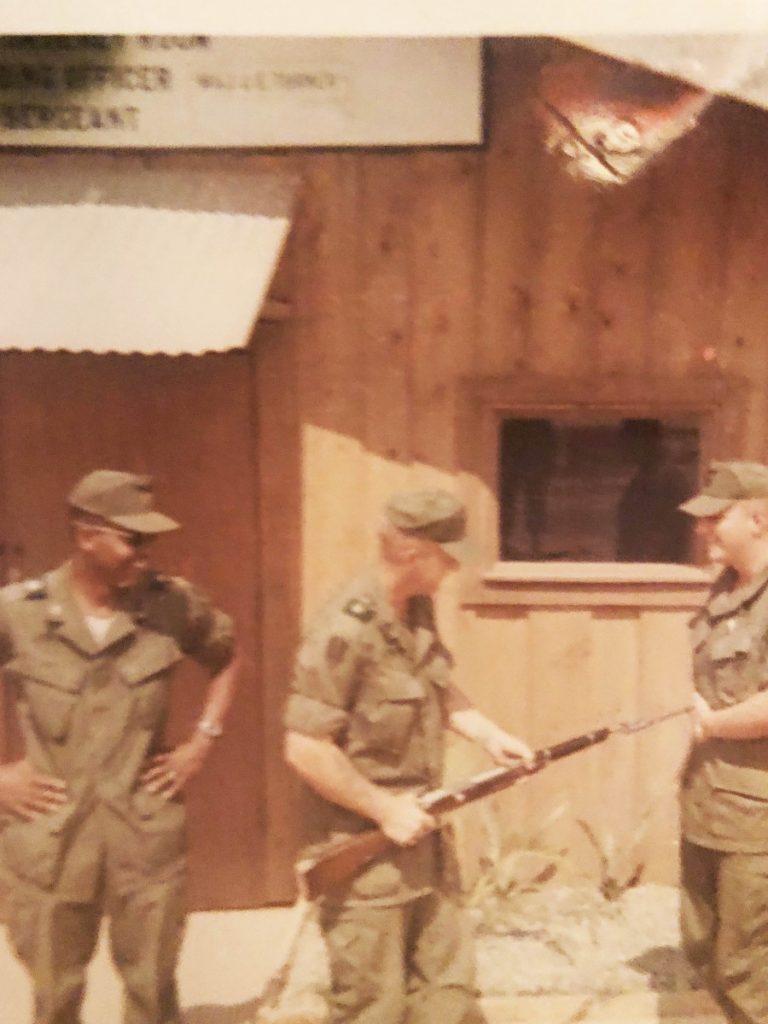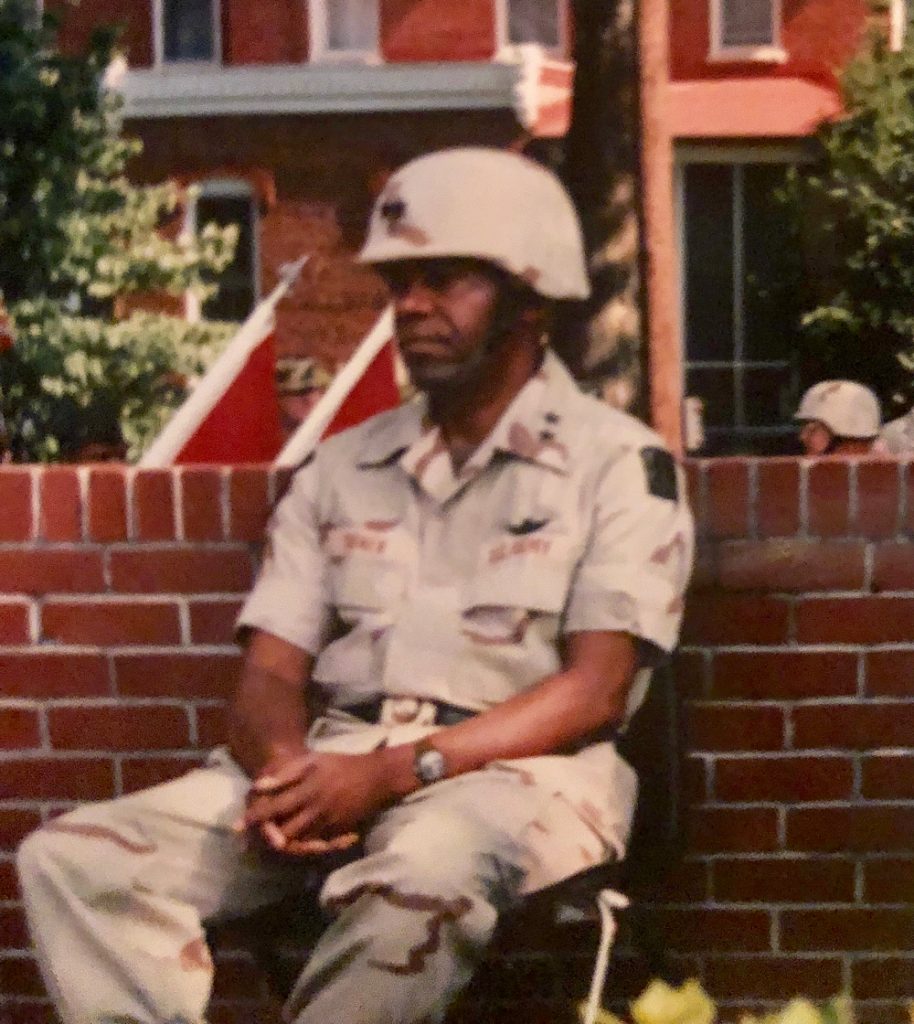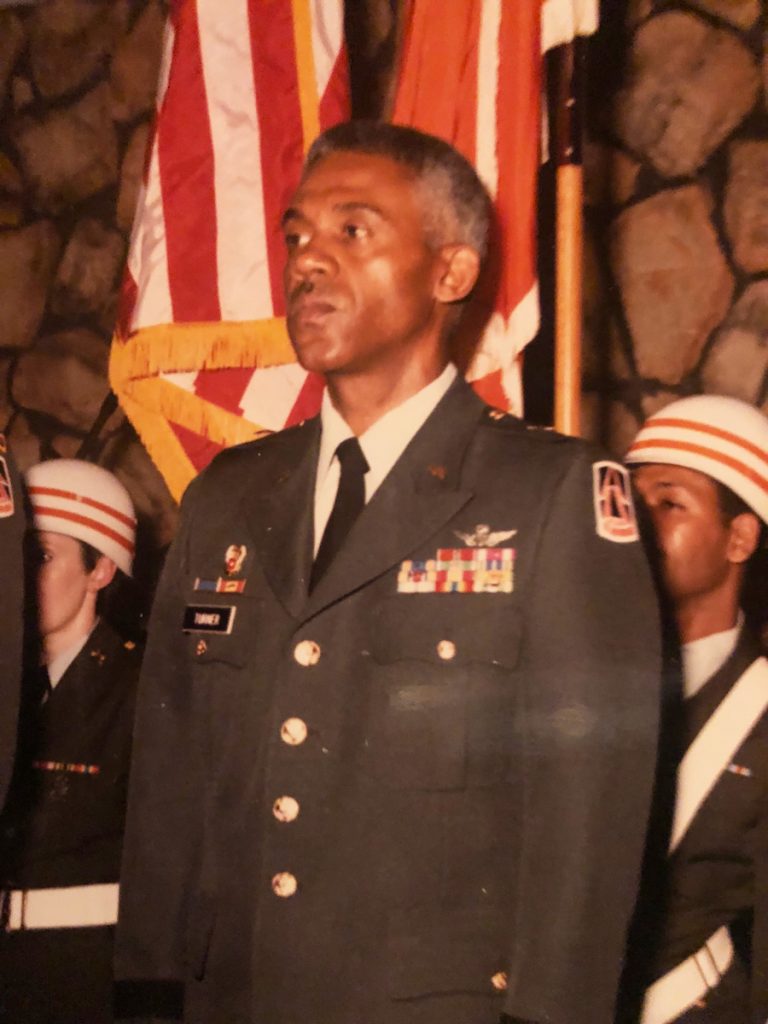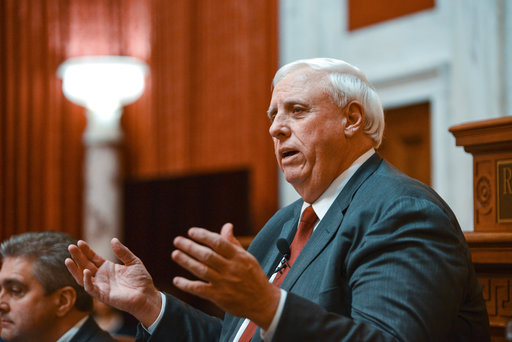The jet dropped like a silvery stone out of the sky overtop West Virginia’s capital city. It evened out just over the Kanawha River and roared down its length, water flashing in the jet’s wake.
Crazily, the pilot charged toward a bridge over the river. Was he going to pull up?
Joseph Ellis Turner, age 11, watched in awe as the jet dashed under the bridge, not over it.
Immediately, the jet leapt skyward like a firework. It rolled once in the sky.
And was gone.
The year was 1950. Turner, now age 79, recalled his reaction as he stood stunned by what he’d just seen the daredevil West Virginia aviator Chuck Yeager do.
“I want to be like that guy,” he said.
‘Just a Guy Trying to Survive’
Turner would indeed follow Yeager up into the sky.
The Charleston native’s career as a front-line pilot in Vietnam, as the first African-American Brigadier General in the South and as a long-haul Delta Airlines pilot would be an esteemed one. So esteemed that on August 5, Turner was inducted into the West Virginia Aviation Hall of Fame.
He joins the likes of famed Tuskegee Airman George “Spanky” Roberts, West Virginia’s first African-American military pilot, and Katherine Johnson, famous for her math genius that helped NASA put humans into space and on the moon.
Don’t call Turner a hero, though. He’ll turn down the offer. “I’m just a guy out here trying to survive.”
Survive, he did. And thrive, even in the face of segregation, growing up in a segregated neighborhood in Charleston and later facing the segregation of the U.S. Army’s flight training program.
He’ll eventually get around to telling you, in his happy-go-lucky and self-effacing way, how even segregated cafeterias helped his Hall of Fame career.
“Everything I’ve done I’ve enjoyed,” Turner said.“I don’t know how I fell into all this. I think I’ve been blessed by God because I’m not the smartest individual in the world, believe me. But it’s always worked out for me.”
A Role Model Closer to Home
The bad-ass white guy in the jet was surely a lifelong inspiration. “He inspired the devil out of me,” Turner said.
Yet Turner has never met the legendary Yeager–though he’d like to.
But there was a legendary black guy who was an equal, if not greater, inspiration to Turner. That is perhaps because he knew Charles Rogers personally. He grew up with Rogers after Turner’s parents split up and he moved to Fayette County to live on his grandparents’ farm for some years.
Turner tended to the pigs and horses as his grandfather trooped off daily to slip underground into a local coal mine. And he soon took notice of the older kid, 10 years his senior, who lived nearby.
“I lived right around the hill from him. I won’t say around the block,” he said, chuckling, given their upbringing amid the hills and hollers of southern West Virginia.
Rogers was an All-American before the term was ever bandied about. He was a star in multiple sports and a straight-A student with a lifelong laser focus on God and church life who went on to graduate in 1951 from West Virginia State College (now University) in Institute. Rogers was part of a book-worthy crop of African-American officers that trained in the small college’s ROTC program, who would serve with distinction in the Vietnam War and beyond.
Turner, who followed Rogers a decade later into the battle zones of Southeast Asia, knows Rogers’ story by heart. In 1968, Rogers’ battalion was overrun by North Vietnamese on a march south along Ho Chi Minh Trail heading to Saigon. With bombs exploding and bullets flying, his 300 troops faced off with about 3,000 North Vienamese. He was shot in the face, leg and arm, but Rogers pushed through two days of hand-to-hand combat. And survived.
Rogers was later awarded the Congressional Medal of Honor for “dauntless courage and heroism” that day. He finished his career as a two-star general. He died in 1990.
A bronze bust of Rogers is now displayed at West Virginia State University honoring the notable black soldiers and commanders produced by the school. On the “Wall of Stars” behind the Rogers bust are bronze plaques, one honoring another two-star African-American general from the Mountain State: Joe Turner.
Turner, visiting from his home near Los Angeles, was inducted into the school’s ROTC Hall of Fame in 2016 along with several other generals and ROTC graduate soldiers who went on to distinguished careers.The wall plaques laud 15 of the school’s ROTC members who achieved the rank of one-star brigadier general, two-star major general and three-star lieutenant general.
Just like his boyhood hero, Charles Rogers, Turner would achieve the same high rank by the end of his own impressive career.
‘First Class in My Own Mind’
Humid air enveloped a rural Alabama airport. The summer day was quiet. From a distance, came a buzz like a swarm of locusts.
It was indeed a swarm, not of insects but of de Havilland Caribou jets, made in Canada.
In 1962, the Caribou were a new thing the U.S. Army was testing. The STOL—Short Takeoff and Landing—planes could be put down and lifted off from a strip no longer than a few football fields.

As the squadron of Caribou touched down, most of the flight crews that got out to refuel and eat were white guys. But Joe Turner was there and one other black pilot who had survived the training so far. This was the Deep South in the early 1960s. The airport cafeteria was off-limits to a black man.
Turner shrugged it off. He’d brought a sack lunch. He refueled. He took off with his mates.
“It didn’t bother me. That’s the way it was and we accepted it,” he recalled. “You couldn’t do anything about it.”
Not spending time in segregated cafeterias meant he left sooner. He got more flight time in. So, Turner finished the Caribou training before many of his classmates–certainly one of the few historical benefits from segregation’s long, painful history.
“It was great because when it came time to graduate we were finished about two months ahead of everybody else. Because we were flying all the time!”
It wasn’t as if Turner wasn’t already intimately familiar with segregation. Growing up in Charleston, he wasn’t welcome to eat downtown at local landmarks.
It didn’t bug him. He says he was never really upset by it. But his mother was.
Turner learned early on useful life lessons from her. She drove a mail truck at the state Capitol, an unusual job at the time for a black woman.
He ended up working around the Capitol, too. Then, he followed his mother into the privileged homes of the well-to-do in the South Hills neighborhood where she cleaned houses. She taught him how to do a job right the first time, he said, and how to get along with people no matter their skin color.
“It never bothered me being a second-class citizen. I mean, I was first class in my own mind, as far as I’m concerned. That’s the big thing.”
Line of Sight
Flying Caribous in the early ‘60s was fun, Turner remembers. They’d keep the trainees flying huge distances, topping up the plane’s gas and oil tanks mid-flight from tanks in the cargo hold.
“We didn’t know why we were doing it,” he said. “We’d just take off and go up and down the coasts. Turn around in Massachusetts, come back down the coast. Fly to Florida. Go down to Puerto Rico and land.”
It turned out there was a method to such flights, which could last up to 15 hours.
“They were getting us ready to go to Vietnam,” Turner said.“They wanted these aircraft to be over in Vietnam.”.
He began his military career as a Second Lieutenant in the U.S. Army Signal Corps. In 1965, he got a call while on leave in Institute, just outside of Charleston, to pack up. He was bound for war.
Turner had a wife and two kids by then. His family didn’t want him to go. “But I had an obligation. I’m an officer in the Army. I’m ready to do my job.”

All the other black pilots had washed out or quit Caribou training so Turner was the only black pilot among those who flew a squadron of the planes, hopscotching across America, then to Hawaii, Wake Island, Guam, the Philippines and on into Vietnam.
The 16 Caribou planes and crews were sent to the country’s central highlands and the front lines. They provided support to the First Air Cavalry Division. (The division’s story was told in the movie “We Were Soldiers,” starring Mel Gibson.)
Turner’s first mission was to fly a Caribou to snatch back the remains of a helicopter pilot shot down weeks before. The body bag was put in the back of his plane. “The smell was terrible,” he said.
He thought he might have more such missions. “Luckily, I didn’t.”
Training flights in America became the real thing in Vietnam’s skies. The only way for a commander to send orders to front-line troops was by line-of-sight— from headquarters to a bunch of radio antennas hanging out the backside of a Caribou.
“The commander of the division could call through to my aircraft. And the aircraft would relay it back to whoever was fighting on the ground,” Turner said.
He piloted racetrack-shaped figure-eights at 10,000 feet. The flights sometimes lasted 10 hours. America had air superiority over the Vietnamese, “so nothing was going to fly and knock us out of the air,” he said.
Ground fire was a hazard, however.
“My aircraft did get hit a few times. Small round ammunition. We didn’t have anyone killed. But you could find the bullet holes in the airplane. The crew chief would find them and patch ‘em.”
Turner once looked down and saw clouds of smoke billowing in the jungles below. “What the hell is that coming from?” he wondered aloud. “They really have a battle down there.”
But the battle was coming from up above his head.
“The B-52s had been called in. And they’re flying over our heads and dropping those bombs,” he recalled. “Did they see us? I don’t know. That’s something that made me nervous.”
Six months later, Turner moved on to serve as a signal officer with the 17th Aviation Combat Group. His second tour of duty was as commander with the Headquarters Company of the 210th Combat Aviation Battalion. It took him off routine duty over the front lines.
“Generals would come in and visiting Congressmen would come over. We would fly them to wherever the mission was. Which was pretty good duty.”
A Wasted War
Turner retired from active duty in 1970.
“They were going to send me back a third time to Vietnam flying helicopters and I didn’t want to do that.”
Ask him today about what he thinks about the Vietnam War, and his answer, after a slight pause, comes out in a tumble of words.
“I thought it was a waste. We were getting a whole bunch of people killed for no damn reason. Because of politics is what it was.”
It wasn’t just American lives wasted, he said.
“Think of all the Vietnamese we killed. And that Agent Orange stuff we sprayed over there to defoliate the jungle, so they could see who they were shooting at? That stuff got into our system and killed a bunch of people.”
The toll from Agent Orange is personal for Turner. He’ll attend an internment in Washington, D.C., this month for his dear friend, Lt. Colonel Ron McLeod, another distinguished graduate of the Yellow Jacket Battalion at West Virginia State College.
McLeod, who served in the infantry in Vietnam, died earlier this year. He battled for decades with cancers he traced from exposure to Agent Orange.
“I really loved that guy,” said Turner. “We would talk two or three times a day.”
“It was a wasted war. Just no reason for it.”
A Decorated Career
But even after his retirement, Turner stuck with military life as a reserve officer. He split his reserve service with a long career as a pilot for Delta Airlines, carrying tourists from Los Angeles to Honolulu, among other routes.

His star continued to rise in the reserves. In 1988, he became the first African-American Army Brigadier General in the South with the 335th Signal Command out of Atlanta. The reserve unit had a forward-deployed active duty unit in Iraq, providing communications for the Third Army.
He was later promoted to Major General of the unit, becoming a two-star general.
After that, he became vice director of the Information Systems for Command, Control, Communications and Computers at the Pentagon. The position was the second highest in the Army Signal Corps in the Defense Department.
He retired as a two-star general in 1998.
Turner, a student of history, is pleased with the West Virginia Aviation Hall of Fame honor, which puts him in the same grouping as one of the great Tuskegee Airmen who paved the way for so many distinguished African-American soldiers.
There was a time before the Tuskegee Airmen that people said “black people couldn’t fly airplanes,” Turner said.
His 11 Air Medals, two Bronze Stars, Legion of Merit and other military accolades beg to differ, although Turner doesn’t bring them up in conversation.
He’s just glad to be included in such impressive company on the “Wall of Valor” of the Aviation Hall of Fame.
“I feel like I’m rubbing elbows with some great people. I’m happy to be joining them.”
Douglas John Imbrogno is a freelance writer, editor, video feature producer and climate newsletter editor and podcaster. See more of his work at thestoryisthething.com and ChangingClimateTimes.substack.com



